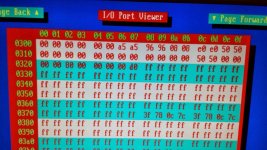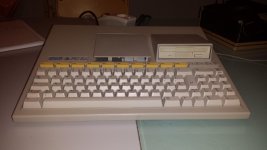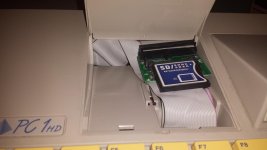Great Hierophant
Veteran Member
As I identified in my first post on this thread, there are four Tandy 1000 machines which use an 8-bit IDE port, the TL/2, TL/3, RL and RLX. The port only puts out A0 and A1, but true AT IDE requires A2, so that line will need to be connected from an ISA slot. I believe the latest builds of the Universal XT-IDE BIOS supports 8-bit CF transfer modes, so no latching hardware will be required.
To avoid having to use an expansion card for the Universal XT-IDE BIOS, the code will have to be added to the existing BIOS ROM. Earlier Tandys, the TL, SL and SL/2 used two physical ROM chips (odd/even) for the ROM. All the Tandys after and including the TL and SL contain 512K of ROM with a fixed 64KB bank at F0000-FFFFF and a bankswitched bank at E0000-EFFFF. The Tandys with an 8-bit IDE port use one 16-bit ROM (40 pins, like a Sega Genesis cartridge ROM). Maybe a M27C800 would work in this system.
So, all an enterprising programmer needs to do is to add a wire to the IDE port, insert the BIOS code into the existing ROM and flash and maybe wire a compatible replacement BIOS EPROM chip! Child's play, right?
To avoid having to use an expansion card for the Universal XT-IDE BIOS, the code will have to be added to the existing BIOS ROM. Earlier Tandys, the TL, SL and SL/2 used two physical ROM chips (odd/even) for the ROM. All the Tandys after and including the TL and SL contain 512K of ROM with a fixed 64KB bank at F0000-FFFFF and a bankswitched bank at E0000-EFFFF. The Tandys with an 8-bit IDE port use one 16-bit ROM (40 pins, like a Sega Genesis cartridge ROM). Maybe a M27C800 would work in this system.
So, all an enterprising programmer needs to do is to add a wire to the IDE port, insert the BIOS code into the existing ROM and flash and maybe wire a compatible replacement BIOS EPROM chip! Child's play, right?



